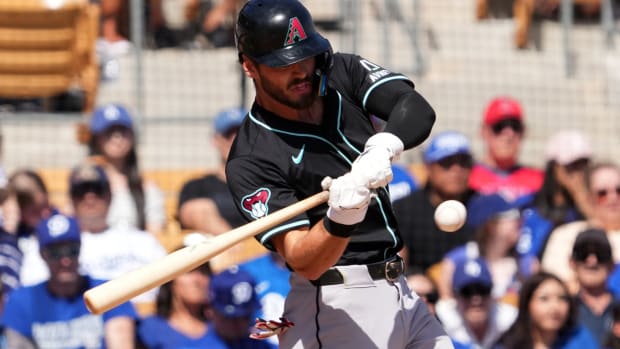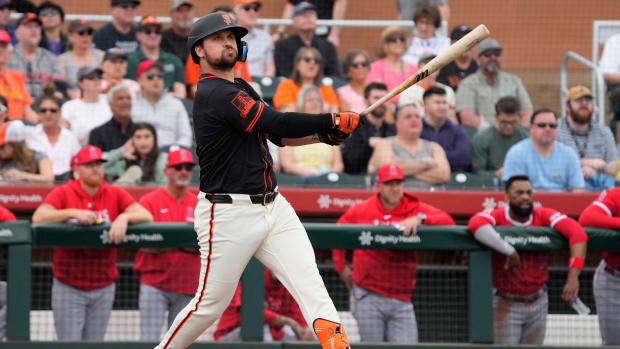Morneau deal curious for Rockies but White Sox smart to bring back Konerko
Former AL Central rivals Justin Morneau and Paul Konerko both figure to be platooned in 2014. (Hannah Foslien/Cal Sport Media)
Overlooked amid the flurry of Hot Stove activity Tuesday night, the Rockies signed first baseman Justin Morneau to a two-year contract worth $13 million. And on Wednesday morning, while most of the baseball world was still digesting the craziness of what SI's Tom Verducci dubbed Chico Salmon Day, the White Sox came to terms on a one-year, $2.5 million deal with first baseman Paul Konerko for what will be his age-38 season.
Both deals represent significant paycuts. For Morneau, the total value of his new contract is $1 million less than he made in 2013 alone. Konerko's deal, $1 million of which is deferred, represents an $11 million reduction compared to this past season. Their new salaries suggest that both the players and their teams recognize what the recent performances of these two former All-Stars demand: that both be platooned in 2014.
Morneau just completed a six-year, $80 million extension he signed with the Twins back in January 2008. At that time, he had averaged 32 home runs and 120 RBIs over the previous two seasons while hitting .296/.359/.525. He was also just one year removed from winning the 2006 American League Most Valuable Player award and was heading in to his age-27 season. Morneau finished second in the MVP voting in 2008, maintained his production in 2009 and was an early MVP candidate in 2010 when he hit his head on Aaron Hill's knee while sliding into second base in Toronto on July 7 and suffered a season-ending concussion.
Post-concussion symptoms and surgery to repair a herniated disc in his neck limited Morneau to 69 games in 2011, and that season ended with three more surgeries to remove a cyst from his left knee, bone spurs from his right foot and fix a subluxing tendon in his left wrist. In two seasons since, Morneau has ostensibly been healthy but, at the ages of 31 and 32, hit just .263/.328/.424 while averaging 18 home runs and 106 strikeouts. Prior to his injuries, Morneau had never struck out 100 times in a season.
Acquired from Minnesota by the Pirates on Aug. 31 of this past season, Morneau failed to hit a single home run for Pittsburgh in 117 at-bats between the regular and postseasons and, perhaps most importantly, over the last two regular seasons, he hit just .221/.260/.289 against lefthanded pitching. On its face, Coors Field may seem like a good place for a hitter to get well and put up some numbers that can convince Morneau's potential 2016 suitors that there's still life in his bat. ON the other hand, spending 81 games hitting in the thin air, where pitches move differently, can just as easily exacerbate a hitter's problems outside of the mountains.
From the Rockies' perspective, it seems inexplicable that, after finally breaking free of an aging first baseman with fading power numbers and a failing body in Todd Helton, the team has chosen to sign a similarly compromised player in Morneau, who will turn 33 in May. However, Morneau's average annual value of $6.5 million suggests that Colorado is at least aware of his platoon splits and sees him as something less than a full-time starter. Indeed, their other big move on Tuesday, the trade that sent centerfielder Dexter Fowler to the Astros, may have landed the Rockies a suitable platoon partner for Morneau in Brandon Barnes.
Barnes, a slick-fielding sophomore outfielder, was useless against righthanders as a rookie this past season, but hit .296/.354/.437 in 148 plate appearances against lefties. Putting Barnes in rightfield and pushing Michael Cuddyer, coincidentally the same man who replaced Morneau at first base with the Twins in 2010, to first base against lefthanded starters would give the Rockies a boost at the plate and in the field, as Barnes is a superlative defensive player. That might actually benefit Morneau, as well. He hit .285/.360/.494 against righties over the last two seasons, numbers which bear greater resemblance to his pre-concussion performance and, if isolated, might lure an unsuspecting general manager into thinking he could shed the platoon after his new contract expires.
As for Konerko, who will be entering his 16th season on the South Side, he may find himself in an even smaller role in 2014 given the White Sox' October addition of Cuban first baseman Jose Abreu. Most likely, Konerko is back to serve as a platoon partner for designated hitter Adam Dunn in the final year of Dunn's contract and for insurance in case Abreu, arguably the best hitter in Cuba prior to his defection, struggles to make the transition to the majors.
Konerko enjoyed a late-career surge in 2010 and '11, hitting .306/.391/.551 while averaging 35 home runs and 108 RBIs in his age-34 and -35 seasons. However, after a similarly hot start to 2012, he was slowed by bone chips in his wrist, which he had removed in early June, and he hasn't been the same hitter since. Over his last 918 plate appearances dating back to June 1, 2012, Konerko has hit a mere .250/.320/.379 and his power and, perhaps as a result, his walk rate have continued to erode.




































